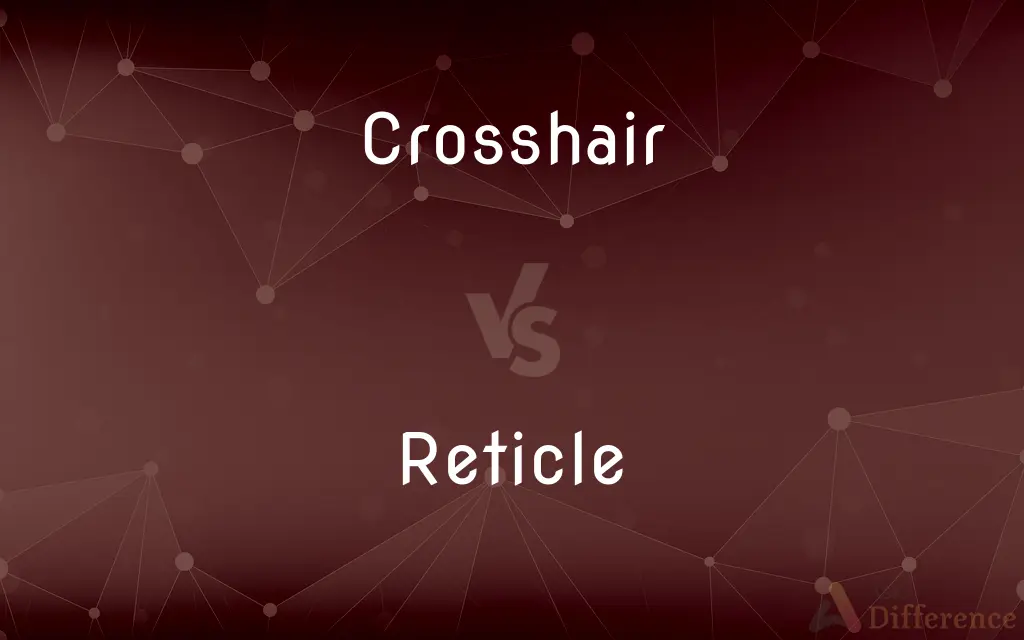Crosshair vs. Reticle — What's the Difference?
By Fiza Rafique & Maham Liaqat — Updated on March 8, 2024
A crosshair is a specific type of reticle with two perpendicular lines that intersect, often used for precision aiming, while a reticle can include various patterns for targeting and measuring in optical devices.

Difference Between Crosshair and Reticle
Table of Contents
ADVERTISEMENT
Key Differences
Crosshairs typically consist of two thin lines that intersect at the center of an optical device, providing a precise aiming point. These lines can be etched onto glass or displayed electronically. On the other hand, a reticle encompasses a wider range of designs, including dots, circles, grids, or combinations thereof, serving not just for aiming but also for range estimation and windage adjustments.
The term "crosshair" is often used in reference to traditional and simple aiming mechanisms in riflescopes and other sighting devices, where the primary goal is to offer a clear and precise point of aim. Whereas reticles can be found in a variety of optical instruments, including telescopes, microscopes, and cameras, offering users different functionalities based on the pattern and design.
Crosshairs are generally favored in scenarios requiring high precision, such as in sharpshooting or hunting, due to their minimalistic design which allows for less visual obstruction. Reticles, with their various patterns, are preferred in more complex applications like tactical shooting and astronomy, where additional information (e.g., range estimation) is beneficial.
In terms of evolution, the crosshair has its origins in simple scopes used for rifles, where the need was primarily for accuracy at a single point. Reticles, however, have developed into complex designs to meet the varied demands of modern optics, incorporating technology and user-specific requirements for enhanced functionality.
Crosshairs and reticles also differ in their customization options. While crosshairs offer limited variation beyond thickness and color, reticles are highly customizable, featuring different shapes, sizes, and additional markers to aid in specific calculations or to enhance visibility in various lighting conditions.
ADVERTISEMENT
Comparison Chart
Definition
Intersection of two lines
Pattern for aiming or measuring
Primary Use
Precision aiming
Aiming, measuring, targeting
Optical Devices
Riflescopes, sights
Scopes, cameras, microscopes
Design Complexity
Simple
Varied, from simple to complex
Customization
Limited to color, thickness
Highly customizable
Visibility
Often minimalistic
Can be designed for better visibility in various conditions
User Preference
Sharpshooters, hunters
Tactical shooters, astronomers
Functionality
Aim precision
Aim, range estimation, windage
Evolution
Traditional, minimalistic
Evolving, technology-driven
Compare with Definitions
Crosshair
A pair of perpendicular lines that intersect at the center of a scope.
The sniper adjusted his rifle until the target was at the intersection of the crosshair.
Reticle
A pattern or set of lines in an optical device used for aiming or measuring.
The telescope's reticle was crucial for accurately tracking stars.
Crosshair
Often used for precise aiming in shooting and hunting.
He preferred the simplicity of a crosshair for quick target acquisition.
Reticle
Found in a variety of optical instruments.
The camera’s reticle assisted in framing the perfect shot.
Crosshair
Minimalistic design aids in reducing visual clutter.
With the crosshair’s minimalistic design, focusing on the target was easier.
Reticle
Can include dots, circles, grids, or other patterns.
The scope’s reticle featured a complex grid pattern for advanced targeting.
Crosshair
Primarily found in optical aiming devices.
His new riflescope featured a fine crosshair for enhanced precision.
Reticle
Offers additional functionalities like range estimation.
Using the reticle’s markings, he could estimate the distance to his target.
Crosshair
Can be illuminated for better visibility.
The illuminated crosshair helped him aim in low light conditions.
Reticle
Highly customizable to fit specific needs.
The custom reticle was designed to facilitate rapid target engagement.
Crosshair
Either of two fine strands of wire crossed in the focus of the eyepiece of an optical instrument and used as a calibration or sighting reference.
Reticle
A reticle, or reticule also known as a graticule, is a pattern of fine lines or markings built into the eyepiece of an optical device such as a telescopic sight, spotting scope, theodolite, optical microscope or the screen of an oscilloscope, to provide measurement references during visual inspections. Today, engraved lines or embedded fibers may be replaced by a digital image superimposed on a screen or eyepiece.
Crosshair
Reticle.
Reticle
A grid or pattern placed in the eyepiece of an optical instrument, used to establish scale or position. Also called graticule.
Crosshair
To focus on within a reticle.
Reticle
A grid, network, or crosshatch found in the eyepiece of various optical instruments to aid measurement or alignment
Crosshair
(by extension) To target.
Reticle
(obsolete) a little bag
Reticle
A small net.
Reticle
A reticule. See Reticule, 2.
Reticle
A network of fine lines, dots, cross hairs, or wires in the focal plane of the eyepiece of an optical instrument
Common Curiosities
Why are crosshairs preferred for precision shooting?
Their simple design minimizes visual obstruction, providing a clear and precise aiming point.
What is a reticle?
A reticle is any pattern or set of lines in an optical device, used for aiming, measuring, or other functions.
Can a crosshair be considered a reticle?
Yes, a crosshair is a specific type of reticle.
Are reticles customizable?
Yes, reticles can be highly customized in terms of shape, size, and additional features to suit specific needs.
Can reticles be illuminated?
Yes, many reticles, including certain crosshairs, can be illuminated for better visibility in various lighting conditions.
What is a crosshair?
A crosshair is an aiming point in the form of two perpendicular lines that intersect, often found in scopes and sights.
What makes reticles suitable for tactical applications?
Their varied designs can include additional markers for range estimation and windage adjustments, offering greater functionality.
How do crosshairs enhance aiming precision?
The intersection of the lines provides a focal point for precise aiming, reducing the margin of error.
Can crosshairs be used in non-shooting applications?
While less common, crosshairs can be used in any optical device requiring a simple point of reference.
How do illuminated reticles work?
Illuminated reticles use battery-powered lights or fiber optics to enhance visibility of the pattern.
What is the main difference between a crosshair and a reticle?
The main difference is that a crosshair is a type of reticle with a simple intersecting line design, while reticles can have various patterns for different purposes.
Why would someone choose a reticle over a simple crosshair?
For applications requiring more information than just an aim point, such as ballistic calculations or range estimation.
Are there optical devices that offer interchangeable reticles?
Yes, some advanced optical devices allow users to change reticles to suit different situations or preferences.
Do all optical devices use reticles?
Many optical devices use reticles, but not all. Some applications may not require them.
What are the benefits of a complex reticle pattern?
Complex patterns can provide valuable information, such as distance to the target, windage corrections, and ballistic drop compensations.
Share Your Discovery

Previous Comparison
Bravery vs. Valour
Next Comparison
Determined vs. IdentifiedAuthor Spotlight
Written by
Fiza RafiqueFiza Rafique is a skilled content writer at AskDifference.com, where she meticulously refines and enhances written pieces. Drawing from her vast editorial expertise, Fiza ensures clarity, accuracy, and precision in every article. Passionate about language, she continually seeks to elevate the quality of content for readers worldwide.
Co-written by
Maham Liaqat














































